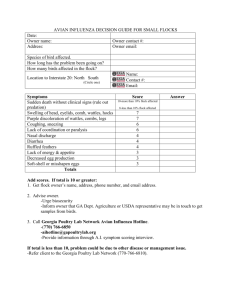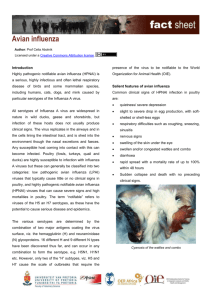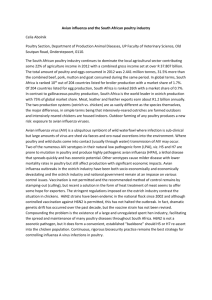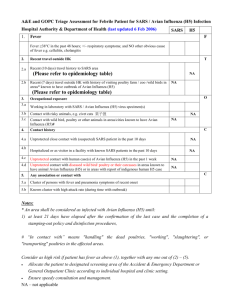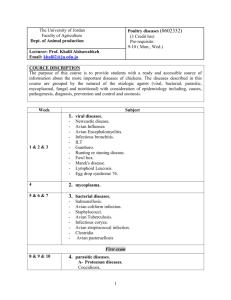Title of thesis/research report
advertisement
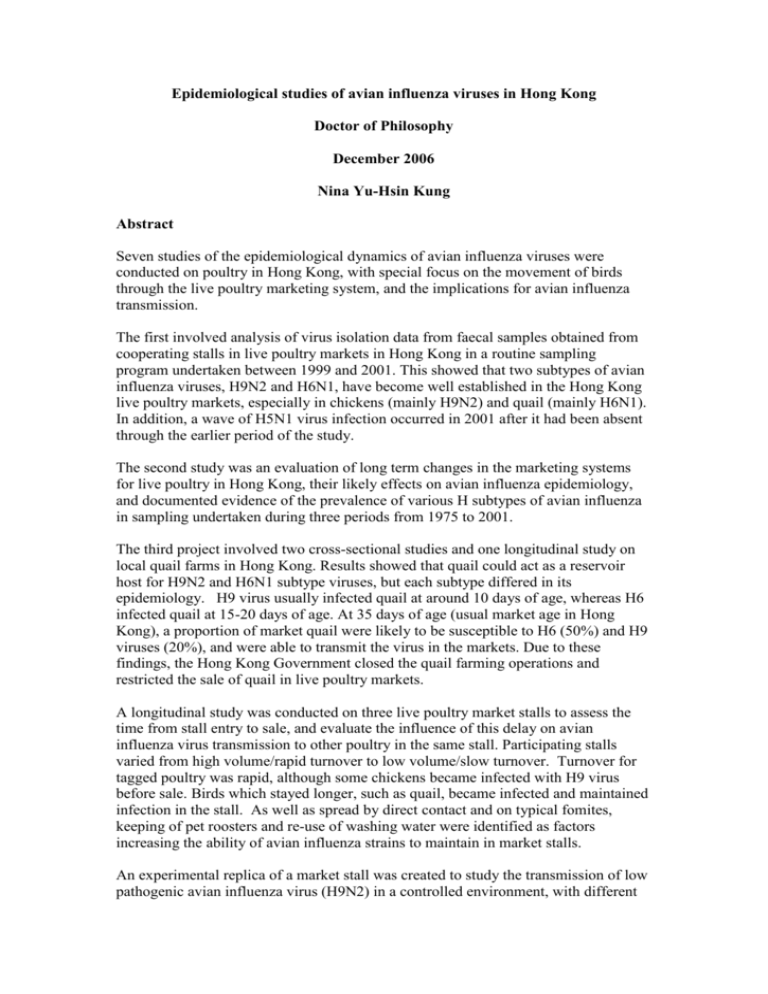
Epidemiological studies of avian influenza viruses in Hong Kong Doctor of Philosophy December 2006 Nina Yu-Hsin Kung Abstract Seven studies of the epidemiological dynamics of avian influenza viruses were conducted on poultry in Hong Kong, with special focus on the movement of birds through the live poultry marketing system, and the implications for avian influenza transmission. The first involved analysis of virus isolation data from faecal samples obtained from cooperating stalls in live poultry markets in Hong Kong in a routine sampling program undertaken between 1999 and 2001. This showed that two subtypes of avian influenza viruses, H9N2 and H6N1, have become well established in the Hong Kong live poultry markets, especially in chickens (mainly H9N2) and quail (mainly H6N1). In addition, a wave of H5N1 virus infection occurred in 2001 after it had been absent through the earlier period of the study. The second study was an evaluation of long term changes in the marketing systems for live poultry in Hong Kong, their likely effects on avian influenza epidemiology, and documented evidence of the prevalence of various H subtypes of avian influenza in sampling undertaken during three periods from 1975 to 2001. The third project involved two cross-sectional studies and one longitudinal study on local quail farms in Hong Kong. Results showed that quail could act as a reservoir host for H9N2 and H6N1 subtype viruses, but each subtype differed in its epidemiology. H9 virus usually infected quail at around 10 days of age, whereas H6 infected quail at 15-20 days of age. At 35 days of age (usual market age in Hong Kong), a proportion of market quail were likely to be susceptible to H6 (50%) and H9 viruses (20%), and were able to transmit the virus in the markets. Due to these findings, the Hong Kong Government closed the quail farming operations and restricted the sale of quail in live poultry markets. A longitudinal study was conducted on three live poultry market stalls to assess the time from stall entry to sale, and evaluate the influence of this delay on avian influenza virus transmission to other poultry in the same stall. Participating stalls varied from high volume/rapid turnover to low volume/slow turnover. Turnover for tagged poultry was rapid, although some chickens became infected with H9 virus before sale. Birds which stayed longer, such as quail, became infected and maintained infection in the stall. As well as spread by direct contact and on typical fomites, keeping of pet roosters and re-use of washing water were identified as factors increasing the ability of avian influenza strains to maintain in market stalls. An experimental replica of a market stall was created to study the transmission of low pathogenic avian influenza virus (H9N2) in a controlled environment, with different rates of population turnover and different immune status with respect to both H5 and H9 subtypes. Transmission was influenced by distance between birds, the proportion of birds carrying antibody to H9 and the rate of introduction of susceptible birds, but not by the use of H5N2 vaccine. In order to assess the effectiveness of temporary depopulation of stalls, a study was conducted to compare the prevalence of avian influenza virus and Newcastle disease virus before and shortly after the monthly rest day in live poultry markets in Hong Kong, by virus isolation. Prevalence of H9N2 avian influenza virus was reduced by the rest day, but Newcastle disease virus prevalence was unaffected. During the 2002 avian influenza H5N1 outbreak in local chicken farms, a case-control study was undertaken to identify risk factors that may have contributed to this outbreak. A questionnaire was administered by interview to collect the data for this study. Multivariate logistic regression models showed that movement of people and fomites from live poultry markets to farms were important influences on transmission, and that the live bird markets were the likely source of virus for farms. A spatial stochastic computer model was constructed to predict the spread of avian influenza virus in local chicken farms and live poultry markets in Hong Kong, and the effectiveness of control measures. The data used in model parameter setting was derived from the case-control study. The reference model produced an epidemic curve which was similar to the true epidemic curve in the 2002 outbreak. Control strategies such as rest day and vaccination were evaluated within the model, and found to produce results comparable with field experience. Results from these studies clarify various aspects of the epidemiological features and transmission dynamics of avian influenza viruses, and provide guidance on appropriate control and prevention strategies for highly pathogenic avian influenza viruses within poultry marketing systems in Asia.



